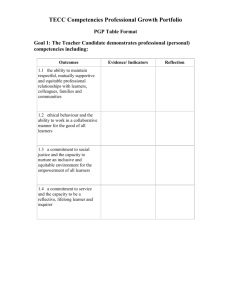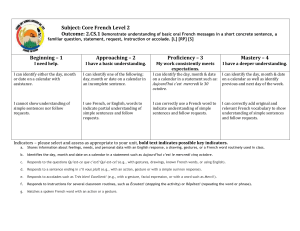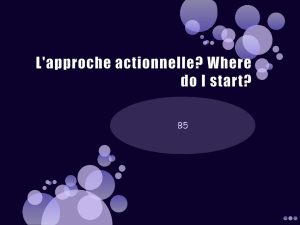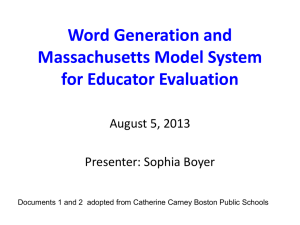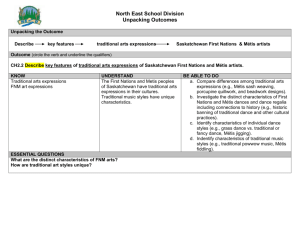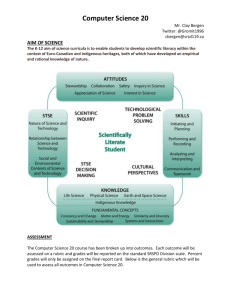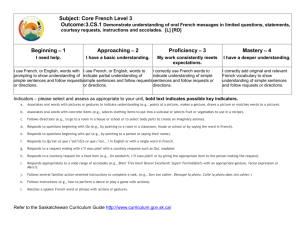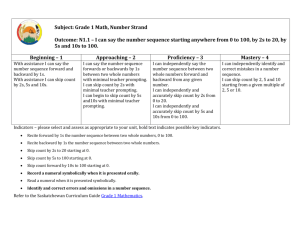Level 1
advertisement
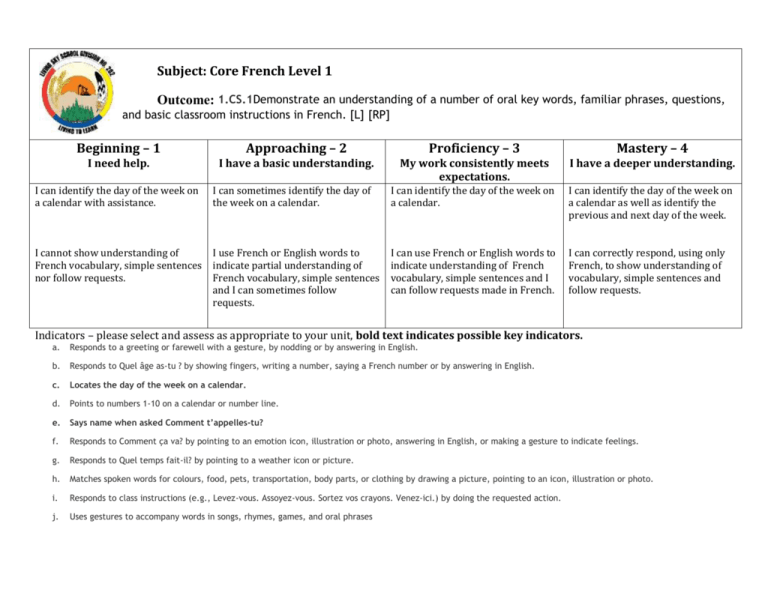
Subject: Core French Level 1 Outcome: 1.CS.1Demonstrate an understanding of a number of oral key words, familiar phrases, questions, and basic classroom instructions in French. [L] [RP] Beginning – 1 Approaching – 2 Proficiency – 3 Mastery – 4 I need help. I have a basic understanding. My work consistently meets expectations. I have a deeper understanding. I can identify the day of the week on a calendar with assistance. I can sometimes identify the day of the week on a calendar. I can identify the day of the week on a calendar. I can identify the day of the week on a calendar as well as identify the previous and next day of the week. I cannot show understanding of French vocabulary, simple sentences nor follow requests. I use French or English words to indicate partial understanding of French vocabulary, simple sentences and I can sometimes follow requests. I can use French or English words to indicate understanding of French vocabulary, simple sentences and I can follow requests made in French. I can correctly respond, using only French, to show understanding of vocabulary, simple sentences and follow requests. Indicators – please select and assess as appropriate to your unit, bold text indicates possible key indicators. a. Responds to a greeting or farewell with a gesture, by nodding or by answering in English. b. Responds to Quel âge as-tu ? by showing fingers, writing a number, saying a French number or by answering in English. c. Locates the day of the week on a calendar. d. Points to numbers 1-10 on a calendar or number line. e. Says name when asked Comment t’appelles-tu? f. Responds to Comment ça va? by pointing to an emotion icon, illustration or photo, answering in English, or making a gesture to indicate feelings. g. Responds to Quel temps fait-il? by pointing to a weather icon or picture. h. Matches spoken words for colours, food, pets, transportation, body parts, or clothing by drawing a picture, pointing to an icon, illustration or photo. i. Responds to class instructions (e.g., Levez-vous. Assoyez-vous. Sortez vos crayons. Venez-ici.) by doing the requested action. j. Uses gestures to accompany words in songs, rhymes, games, and oral phrases Subject: Core French Level 1 Outcome: 1.CS.2 Provide basic personal information through oral expression supported by constant prompting. [S] Beginning – 1 Approaching – 2 Proficiency – 3 Mastery – 4 I need help. I have a basic understanding. My work consistently meets expectations. I have a deeper understanding. I can use minimal French words to tell about myself with prompting. . I can use generally accurate French vocabulary to tell about myself with prompting . I can specifically tell about myself in French with prompting. I can add original and relevant French vocabulary to tell about myself. I can repeat common polite phrases to greet, bid farewell and say thankyou. I can sometimes use common polite phrases to greet, bid farewell and say thank-you. I can correctly use common polite phrases to greet, bid farewell and say thank-you. I can spontaneously use common polite phrases to greet, bid farewell and say thank-you. Indicators – please select and assess as appropriate to your unit, bold text indicates possible key indicators. a. Names and correctly pronounces the French word for some familiar classroom objects, dates, animals, and people for theme-related words. b. Names the correct colours (e.g., familiar objects or animals). c. Responds to a question with a short sentence (e.g., Comment t’appelles- tu? Je m’appelle Sarah. Quel âge as-tu? J’ai six ans.). d. Indicates thanks by saying Merci!, and you’re welcome by saying De rien. e. Expresses feelings with a short sentence (e.g., Ça va bien. Ça va mal. Ça va comme ci, comme ça.). f. Explains preferences with short sentences such as J’aime le chocolat. g. Uses the culturally correct form of greetings and farewells such as Salut! for both greetings and farewells, as well as Bonjour! for a greeting, and Au revoir! for a farewell. h. Uses a previously learned word or phrase to participate in a game with others. Refer to the Saskatchewan Curriculum Guide http://www.curriculum.gov.sk.ca/ Subject: Core French Level 1 Outcome: 1.CS.4 Reproduce, with prompting and support, a single French key word in print. [W] Beginning – 1 Approaching – 2 Proficiency – 3 Mastery – 4 I need help. I have a basic understanding. My work consistently meets expectations. I have a deeper understanding. I can match a picture and a label. I can write a partially correct label in French for a picture using supports. I can correctly label a picture in French using suppports. I can correctly label a picture in French without support. Indicators – please select and assess as appropriate to your unit, bold text indicates possible key indicators. a. Labels illustrations, photos or icons by copying single words (verbs, common adjectives, articles + nouns) from a word wall, poster, or chart (e.g., colours, animals, classroom objects, self, actions). b. Makes illustrations with labels for inclusion in a class book or slideshow (e.g., copying a word from an illustrated list, a book, a sheet, a picture dictionary). c. Labels graphics on an interactive whiteboard. Refer to the Saskatchewan Curriculum Guide http://www.curriculum.gov.sk.ca/ Subject: Core French Level 1 Outcome: 1.GL.1 Use visual and auditory clues with prompting for the interpretation of a listening or viewing experience. [L] [RP] [V] Beginning – 1 Approaching – 2 Proficiency – 3 Mastery – 4 I need help. I have a basic understanding. My work consistently meets expectations. I have a deeper understanding. I can choose a strategy, with assistance, to understand what I hear or see in French. I can choose a strategy to understand what I hear or see in French. I can choose a variety of strategies to understand what I hear or see in French. I can choose and explain strategies that I used to understand what I hear or see in French. Indicators – please select and assess as appropriate to your unit, bold text indicates possible key indicators. Before listening or viewing: a. Responds to a signal to begin listening (e.g., stopping activity and looking at the teacher). b. Makes prompted connections to own experiences (e.g., responds to images, illustrations, topics in English). c. Anticipates, with teacher prompting, the content of the listening experience in English. During listening or viewing: d. Shows interest in the listening experience (e.g., looks at the speaker, the book, an illustration, a photo, a screen or board, leans forward to show interest, or sits quietly). e. Shows interest in the viewing experience (e.g., looks at the speaker, the book, an illustration, a photo, a screen or board, leans forward to show interest, or sits quietly). f. Points to or manipulates real objects or illustrations when requested. g. Points to or manipulates digital objects on an interactive whiteboard when requested. After listening or viewing: h. Identifies the content of the listening experience with teacher prompting (e.g., pointing to an illustration, using a gesture, drawing pictures, using puppets or responding in English). Refer to the Saskatchewan Curriculum Guide http://www.curriculum.gov.sk.ca/ Subject: Core French Level 1 Outcome: 1.GL.2 Use speaking strategies in modeled learning situations. [RP] [L] [S] Beginning – 1 Approaching – 2 Proficiency – 3 Mastery – 4 I need help. I have a basic understanding. My work consistently meets expectations. I have a deeper understanding. I need reminders to use strategies to speak in French activities. I can choose a strategy to speak in French activities. I can choose and self-evaluate the strategies I used to participate in French activities. I can demonstrate to my peers how to choose and self-evaluate appropriate strategies to speak in French activities. Indicators – please select and assess as appropriate to your unit, bold text indicates possible key indicators. a. Repeats new words and phrases. b. Repeats parts of songs or messages. c. Makes gestures accompanying new words and expressions following a model. d. Participates in games, songs and chants using modeled language and gestures. e. Self-evaluates participation in oral activities (e.g., with a thumbs-up or thumbs-down gesture or with icons). Refer to the Saskatchewan Curriculum Guide http://www.curriculum.gov.sk.ca/ Subject: Core French Level 1 Outcome: 1.LK.1 Demonstrate acquisition of French language concepts, related to themes. [S] [L] [R] [RP] o o o numbers 1-10 the difference between an oral question using intonation and a statement knowledge of key words. Beginning – 1 Approaching – 2 Proficiency – 3 Mastery – 4 I need help. I have a basic understanding. My work consistently meets expectations. I have a deeper understanding. I can rarely use French language concepts related to themes. I can sometimes use French language concepts related to themes. I can consistently use French language concepts related to themes. I can skillfully use French language concepts related to themes. Indicators – please select and assess as appropriate to your unit, bold text indicates possible key indicators. a. Counts to ten. b. Names the number of objects in a set, up to 10 objects. c. Identifies any of the numbers from 1 to 10. d. Responds to questions such as Ça va bien? Oui, ça va bien. e. Identifies pictures of key words when asked from the following themes: o o o o o o o o Calendar, Colours, and Shapes Greetings Classroom Routines and Objects Winter Clothing Pets Food Body Transportation. Refer to the Saskatchewan Curriculum Guide http://www.curriculum.gov.sk.ca/ Subject: Core French Level 1 Outcome: 1.C.1 Identify elements of Francophone, First Nations, and Métis cultures with prompting. [S] [RP] Beginning – 1 Approaching – 2 Proficiency – 3 Mastery – 4 I need help. I have a basic understanding. My work consistently meets expectations. I have a deeper understanding. I can vaguely identify elements of Francophone, First Nations and Metis cultures with help. I can identify predictable elements of Francophone, First Nations and Métis cultures with help. I can identify relevant elements of Francophone, First Nations and Métis cultures with help. I can identify relevant elements of Francophone, First Nations and Métis cultures without help. Indicators – please select and assess as appropriate to your unit, bold text indicates possible key indicators. a. Recites a French comptine, sings a First Nations chant, Métis or French song. b. Employs French forms of address such as Monsieur, Madame appropriately to males or females. c. Locates cultural artifacts in the classroom, such as books, posters and flags. d. Sings the Happy Birthday song as Bonne fête (for younger students). e. Names lundi as the first day of the week on a French calendar. f. Names traditional transportation common to First Nations and Métis cultures, such as la charrette de la Rivière Rouge (Red River Cart, le travois (horse or dog drawn skis), le traineau (sled). g. Names items of traditional First Nations, or Métis winter clothing such as l’anorak (hooded waterproof parka), l’atiqik (goose down parka), une cape de bison (bison cape). h. Participates in Francophone or First Nations and Métis cultural activities, such as games, singing, rhymes, and chants. i. Self-evaluates participation in cultural activities (e.g., with a thumbs-up or thumbs-down gesture, or with icons). Refer to the Saskatchewan Curriculum Guide http://www.curriculum.gov.sk.ca/
